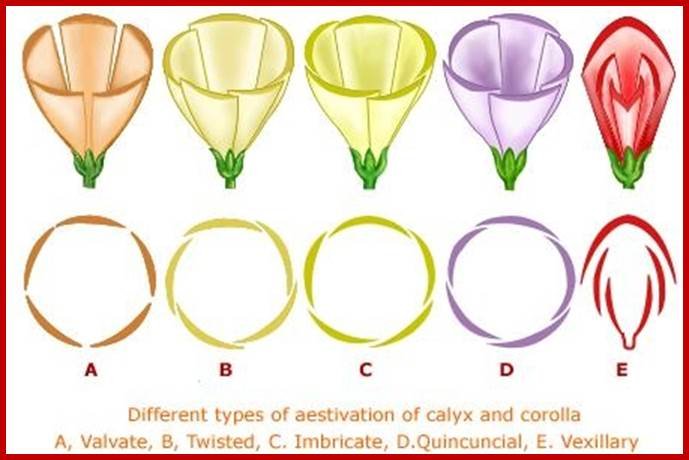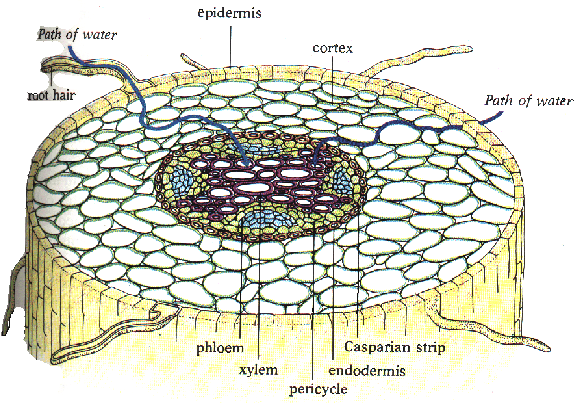Modifications of roots
- Roots are the part of the plant which is mainly used for support and anchorage of plants.
- Some of the roots like carrot and radish are modified to perform a special function like storage of food. The food stored in the roots is utilized during unfavorable conditions.
- Roots like Rhizophora, are modified for gaseous exchange. They have minute pores which help to exchange gases.
- Stilt roots provide mechanical support to the plant e.g., sugarcane.
- Climbing roots provide aerial support to the plant e.g., vanilla.
- Clinging roots provide mechanical support to the plants e.g., orchids.
- Sucking roots helps to withdraw nutrition from other parts of the plant e.g., cuscuta.
- Floating roots help the aquatic plants to store air e.g., water lily.
- Assimilatory roots perform photosynthesis e.g., trapa.
Root modification

Roots are modified for support, storage of food, respiration.
- For support: Prop roots in banyan tree, stilt roots in maize and sugarcane.
- For respiration: Pneumatophores in Rhizophora (mangrove).
- For storage of food: Fusiform (radish), Napiform (turnip), Conical (carrot).
Modification of stem
The stem is the part of the plant that provides support and helps in conduction.
In some plants, the stem is modified for some other functions such as:
In some plants, the stem is modified for some other functions such as:
- Underground stem modification- in such modification, stems remain under the soil and store the large amount of food e.g., potato, ginger etc.
- Sub-aerial modification- in such modification, week stems lie horizontally on the ground and develop adventitious roots that help in vegetative propagation e.g., grass, pumpkin etc.
- Aerial stem modification- in such modification, axillary buds are modified to thron and tendril for protection and support e.g., rose, pea etc.
Stem modification
In some plants the stems are modified to perform the function of storage of food, support, protection and vegetative propagation.
- For food storage: Rhizome (ginger), Tuber (potato), Bulb (onion), Corm (colocasia).
- For support: Stem tendrils of watermelon, grapevine, cucumber.
- For protection: Axillary buds of stem of citrus, Bougainvillea get modified into pointed thorns. They protect the plants from animals.
- For vegetative propagation: Underground stems of grass, strawberry, lateral branches of mint and jasmine.
- For assimilation of food: Flattened stem of Opuntia contains chlorophyll and performs photosynthesis.
Parts of leaf

- Leaf is green in colour.
- The green pigment is known as
- The part of a leaf by which it is attached to the stem is called petiole.
- The broad part of the leaf is known as lamina.
- The lines on the leaf are known as veins which help in transportation in leaves.
- The centre vein is known as midrib.
- The arrangement of veins is known as venation.
Types of leaves
Leaves are of two types:
1) Simple leaf
1) Simple leaf
- A leaf having a single or undivided lamina is called simple leaf.
- A compound leaf is that where the lamina is completely broken up into distinct segments or leaflets which are separately articulated at the base.
- They are of two types, pinnate compound leaves and palmate compound leaves.
Inflorescence
- Inflorescence is the arrangement of flowers on the branch of the plant.
- The main types of inflorescence are racemose and cymose inflorescence.
- In racemose inflorescence the terminal bud continues to grow further resulting in orientation of youngest flower at the apex and oldest at the base.
- In cymose inflorescence the terminal bud grows and dies resulting in the orientation of oldest flower at the apex and young flower at the base.
Types of inflorescence
- Solitary flowers are formed by direct transformation of shoot tips into flowers.
- Racemose inflorescence shows indefinite growth and bears a number of flowers due to the presence of active growing point.
- Cymose inflorescence is a definite inflorescence in which the tip of the main axis terminates in a flower and further growth continues by one or more lateral branches which also behaves like the main axis.
- Mixed inflorescence is one in which two or more inflorescence get mixed up.
- Specialized inflorescence include hypanthodium, verticillaster and cyathium.
Unisexual flowers and Bisexual flowers
- The flowers which contain either only the pistil or only the stamens are called unisexual flowers. For example, corn and papaya.
- The flowers which contain both stamens and pistil are called bisexual flowers bisexual flowers. For example, mustard and rose
Aestivation

Aestivation is arrangement of accessory floral organs in relation to one another in the floral bud. It is of five types. From the givem diagram of aestivation we can conclude that
- Valvate: Margins of the adjacent petals touch each other but do not overlap e.g., sepals of Hibiscus.
- Twisted: Margin of one petal overlaps with the margin of another petal e.g., petals of Hibiscus.
- Imbricate: There is irregular overlapping of petals e.g., Legumes.
- Quincuntial: It occurs in flower with five petals. In such arrangement, two petals or sepals are outside, two are insede and fifth is outside on one margin and inside on another margin e.g., Guava.
- Vexillary: It occurs in flower whorl of five petals. In such arrangement, one posterior petal is largest which covers two lateral petals. These two lateral petals covers two interior or smallest petals e.g., Pea.
Structure of dicot and monocot embryo
Structure of monocot embryo
- The embryos of monocotyledons have only one cotyledon.
- In grass family (Gramineae), this cotyledon is called scutellum. It is situated towards lateral side of embryonal axis.
- This axis at its lower end has radicle and root cap enclosed in a sheath called coleorhiza.
- The part of axis above the level of attachment of scutellum is called epicotyl.
- It has shoot apex and few leaf primordia enclosed in a hollow foliar structure called coleoptile.
- A typical dicotyledonous embryo consists of an embryonal axis and two cotyledons.
- The part of embryonal axis above the level of cotyledons is called epicotyl.
- It terminates with the stem tip, called plumule (future shoot).
- The part below the level of cotyledons is called hypocotyl which terminates in the root tip called radicle (future root).
- The root tip is covered with a root cap (calyptra).




Comments
Post a Comment